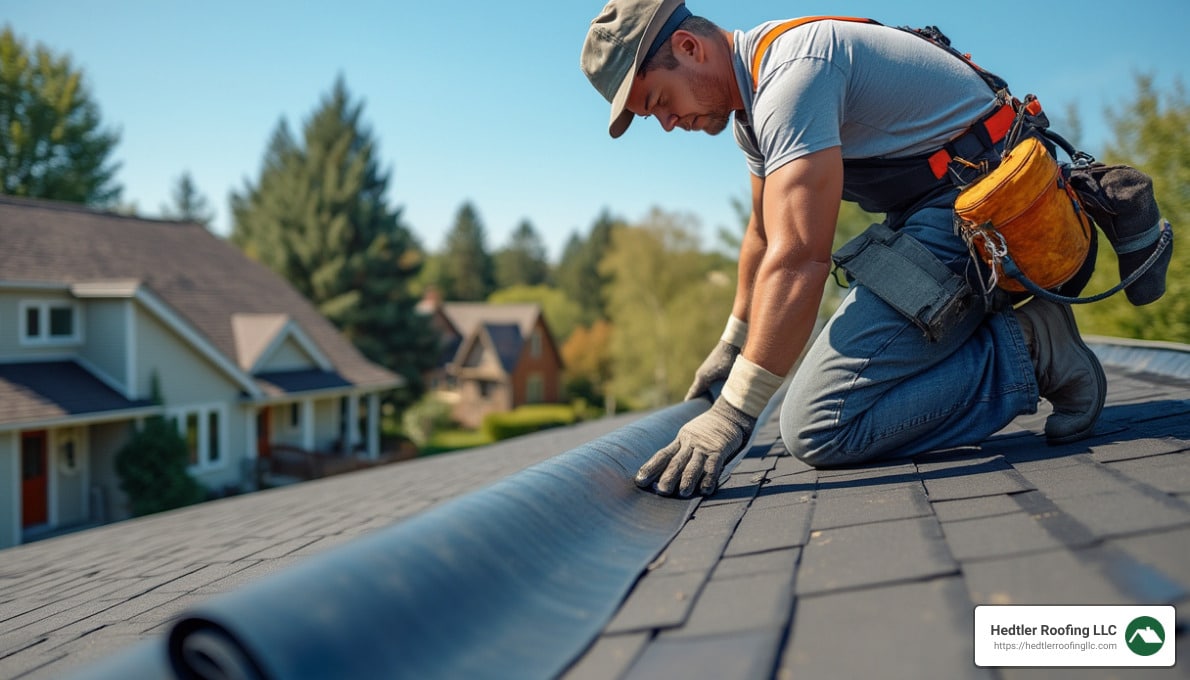New Felt Roof: Top 5 Essential Tips for 2024 Success
New felt roof installations offer a durable and reliable solution for homeowners looking to protect their homes from Massachusetts’ unpredictable weather. A new felt roof serves as a traditional and effective waterproof barrier, ensuring your home remains secure and dry regardless of weather conditions. If you’ve been considering updating your roof, here’s a quick overview of the essentials for a new felt roof:
- Durability: Roofing felt is known for its longevity and ability to withstand varying weather conditions.
- Waterproof: The felt acts as a crucial barrier against water, protecting the underlying roof deck.
- Traditional Appeal: Felt has been a go-to material in roofing for decades, providing a balance of style and function.
As the owner of Roof Experts, I, Jason Hedtler, bring over 20 years of experience in installing and maintaining new felt roof systems for homeowners in Bellingham, MA, and the surrounding areas. With a focus on quality and customer satisfaction, my team and I are dedicated to ensuring your home is shielded with a robust new felt roof.

Assessing Your Current Roof
Before diving into a new felt roof installation, it’s crucial to assess the condition of your current roof. This step ensures that your new roof will have a strong foundation and can perform optimally for years to come.
Condition Assessment
Begin by conducting a thorough condition assessment. Look for visible signs of wear and tear, such as cracked or missing shingles, which can expose your roof to water damage. Pay special attention to any water stains or discoloration on the ceiling or walls inside your home, as these can indicate leaks.
Pro Tip: After a storm, check your attic for wet insulation or damp spots. Leaks often show up there first.
Damage Inspection
A detailed damage inspection is vital to identify any underlying issues. Inspect the flashing around chimneys, skylights, and vents. Faulty flashing can lead to leaks, as seen in a case study from Massachusetts where rusty flashing caused significant attic mold growth. Early detection saved the homeowner thousands in repairs.
Fact: Excessive granule loss on shingles is a sign they are nearing the end of their life.
Roof Decking
The roof decking, or sheathing, is the backbone of your roof. It must be solid and free of damage before installing a new felt roof. Check for structural weaknesses like sagging, cracks, or soft spots. These can compromise the integrity of your roof and even your entire home.
Warning: If you see light coming through your attic or notice sagging between rafters, call a professional immediately.
Proper assessment and inspection of your current roof ensure that your new felt roof will have a solid and secure foundation. This not only improves the durability of your roofing system but also maximizes its efficiency in protecting your home from the elements.
Choosing the Right Felt for Your New Roof
When selecting the right material for your new felt roof, there are several options to consider. Each material has its own strengths, so choosing the right one depends on your specific needs and budget.
EPDM Rubber Membrane
EPDM (Ethylene Propylene Diene Monomer) is a popular choice for flat roofs due to its durability and flexibility. It can withstand harsh weather conditions and has a long lifespan, often lasting up to 50 years with proper maintenance.
- Pros: High UV resistance, easy to repair, and cost-effective.
- Cons: Standard black EPDM can absorb heat, potentially increasing cooling costs.
Bituminous Waterproofing
Bituminous materials are known for their excellent waterproofing properties. They are often used in torch-on felting, a method that involves applying heat to adhere the material to the roof.
- Pros: Robust waterproofing and fire resistance.
- Cons: Installation requires professional expertise and can be time-consuming.
Polyurethane
Polyurethane roofing is a versatile option that offers strong insulation and protection against weather elements. It’s often used in spray foam applications, creating a seamless and airtight barrier.
- Pros: Exceptional insulation properties and lightweight.
- Cons: Can be more expensive than other options and requires skilled installation.
GRP (Glass Reinforced Plastic)
GRP is a modern material that provides a sleek and durable finish for flat roofs. It’s made from polyester resin reinforced with glass fibers, offering strength and flexibility.
- Pros: Highly durable, UV resistant, and low maintenance.
- Cons: Limited color options and can be slippery when wet.
Choosing the right felt material for your roof is crucial to ensure long-term protection and efficiency. Consider the climate in Massachusetts, your budget, and the specific needs of your home when making your decision. Each material has its pros and cons, so weigh them carefully to find the best fit for your new felt roof.
Installing Your New Felt Roof
Once you’ve chosen the right material for your new felt roof, it’s time to dive into the installation process. Here’s a step-by-step guide to ensure a smooth and effective installation.
Preparation
Check the Weather: Aim for dry, mild days to avoid complications during installation. Early spring or fall in Massachusetts is ideal.
Inspect and Clean the Deck: Before starting, ensure your roof deck is clean and in good condition. Remove any debris, nails, or old underlayment. A clean deck ensures better adhesion of new materials.
Snap Chalk Lines: Mark your roof with chalk lines 33 5/8” above the eave line, then every 34” as you move up. This will guide you in laying the felt straight.
Cleaning
Clear Debris: Run a flat-bottom shovel along the roof decking to find and remove any stray nails or splinters. This step is crucial to prevent damage to the new felt.
Replace Damaged Decking: Any rotten or compromised decking must be replaced to provide a solid base. This ensures the longevity of your new felt roof.
Adhesive Application
Start at the Bottom: Begin applying the roofing felt at the bottom of the roofline. Work your way up to ensure any water that penetrates the roofing material will shed down the felt.
Overlap the Layers: Each layer of felt should overlap the previous one by 3/8 inch. This overlap prevents water from seeping under the felt.
Secure the Felt: Use nails or staples to secure the felt every three to four inches across the lower half of the paper. This keeps the felt in place, even during windy conditions.
Edge Detailing
Trim and Align: When you reach the rake, cut the felt flush with a knife. Align it with your chalk lines for a neat finish.
Detail Around Vents and Pipes: Cut slits in the felt to fit around any vent pipes, ensuring a snug fit to prevent leaks.
Finish with Precision: Before securing the end of a row, walk along it to smooth out any rough spots. This attention to detail ensures a smooth surface for the final roofing material.
Installing a new felt roof requires careful attention to detail, but with the right preparation and technique, it can be a straightforward process. Once the felt is laid correctly, you’re ready to move on to the next phase of your roofing project.
New Felt Roof Maintenance Tips
Maintaining your new felt roof is crucial to ensure it lasts as long as possible. Here’s how you can keep it in top shape with minimal effort.
Periodic Inspections
Regular inspections are key. Aim to check your roof at least twice a year, ideally in the spring and fall. This helps catch any issues early before they become major problems.
- Look for Leaks: Check for water stains on ceilings or walls. Leaks can lead to mold, rot, and structural damage.
- Inspect for Damage: Examine the roof for signs of wear, such as tears or worn-out felt. Damaged areas should be addressed promptly to prevent further deterioration.
Pro Tip: After a storm, check your attic for wet insulation or damp spots. These are often the first signs of a leak.
Damage Repair
If you spot any damage, take action quickly. Small repairs can prevent bigger, more costly problems down the line.
- Repair Tears: Use roofing adhesive or patch kits to fix small tears or holes in the felt.
- Replace Damaged Sections: If a section of felt is beyond repair, it might need replacing. This ensures the waterproof barrier remains intact.
Fact: According to experts, addressing minor issues early can extend the life of your roof significantly.
Minimal Maintenance
Felt roofs require minimal maintenance compared to other roofing materials. However, a few simple practices can go a long way.
- Keep It Clean: Remove debris like leaves and branches regularly. These can trap moisture and lead to mold.
- Check Flashing: Ensure that the flashing around vents and chimneys is intact and secure. Faulty flashing is a common source of leaks.
Tip: Use binoculars for a closer look without climbing onto the roof. If you spot any damage, call a professional for a thorough inspection.
By following these maintenance tips, you can keep your new felt roof in excellent condition with minimal effort. Regular inspections and timely repairs will ensure your roof continues to protect your home for years to come.
Frequently Asked Questions about New Felt Roofs
Do roofers use felt anymore?
Yes, roofers still use felt as a roofing material today. It’s a traditional material known for being a durable and effective waterproof barrier. Felt roofing is often chosen for its ability to provide a reliable layer of protection against water infiltration.
Many Massachusetts homeowners prefer felt because of its cost-effectiveness and ease of installation. It’s a tried-and-true option that continues to be popular for flat roofs and underlays in sloped roofing systems.
How often should a felt roof be replaced?
The lifespan of a felt roof can vary, but with proper maintenance, it typically lasts between 15 to 30 years. The longevity depends on factors like the quality of installation, weather exposure, and maintenance practices.
For example, torch-on felting, a method where felt is applied using heat, often improves durability and extends the roof’s lifespan. Regular inspections and minor repairs can help maximize the life expectancy of your felt roof.
Should you remove old felt when replacing a roof?
When replacing a roof, it’s crucial to assess the condition of the existing felt. If the old felt is in good condition, with no significant damage or moisture issues, you might consider the overlay option. This involves installing the new felt directly over the existing layer, which can provide additional insulation and protection.
However, if the old felt shows signs of wear, damage, or water penetration, it’s best to remove it. This allows for a thorough condition assessment of the roof decking and ensures a clean surface for the new felt. Removing the old felt can prevent potential issues like trapped moisture, which can lead to mold and rot.
In Massachusetts, where weather conditions can be harsh, ensuring the integrity of your roof is essential. Always consult with a professional roofer to determine the best approach for your specific situation.
Conclusion
At Roof Experts, we understand the unique roofing needs of Massachusetts homeowners. With over 20 years of experience, we pride ourselves on delivering high-quality workmanship that stands the test of time. Our expertise in installing and maintaining new felt roofs ensures that your home remains protected against the elements.
Massachusetts weather can be unpredictable, with its share of heavy snow, rain, and wind. That’s why choosing a reliable roofing contractor is crucial. Our team is well-versed in local climate considerations, ensuring that your roof is not only durable but also compliant with regional regulations.
We take a personalized approach to each project, offering free inspections and detailed assessments to help you make informed decisions. Whether you need a new roof installation, replacement, or repair, we’ve got you covered. Our commitment to quality materials and exceptional customer service is what sets us apart.
If you’re considering a new felt roof or any roofing services, we invite you to learn more about our offerings. Let us help you safeguard your home with a roof that combines functionality and aesthetic appeal.
Your satisfaction is our top priority, and we look forward to working with you to ensure your home remains safe and secure for years to come.


